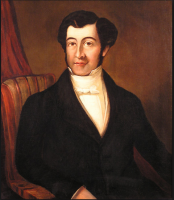










Joseph Bramah born Stainborough Lane Farm, Stainborough, Barnsley Yorkshire, England, was an inventor and locksmith. He is best known for having invented the hydraulic press. Along with William George Armstrong, he can be considered one of the two fathers of hydraulic engineering.
Early life
He was the second son in the family of four sons and two daughters of Joseph Bramma, a farmer, and his wife, Mary Denton. He was educated at the local school in Silkstone and on leaving school he was apprenticed to a local carpenter. On completing his apprenticeship he moved to London, where he started work as a cabinet-maker. In 1783 he married Mary Lawton of Mapplewell, near Barnsley, and the couple set up home in London. They subsequently had a daughter and four sons. The couple lived first at 124 Piccadilly, but later moved to Eaton Street, Pimlico.
Improved water closet
In London, Bramah worked for a Mr. Allen, installing water closets (toilets) which were designed to a patent obtained by Alexander Cumming in 1775. He found that the current model being installed in London houses had a tendency to freeze in cold weather. Although it was Allen who improved the design by replacing the usual slide valve with a hinged flap that sealed the bottom of the bowl, Bramah obtained the patent for it in 1778,and began making toilets at a workshop in Denmark Street, St Giles. The design was a success and production continued well into the 19th century.
His original water closets are still working in Osbourne House, Queen Victoria's home on the Isle of Wight.
Bramah Locks company
After attending some lectures on technical aspects of locks, Bramah designed a lock of his own, receiving a patent for it in 1784. In the same year he started the Bramah Locks company at 124 Piccadilly, which is today based in Marylebone, London and Romford, Essex.
The locks produced by his company were famed for their resistance to lock picking and tampering, and the company famously had a "Challenge Lock" displayed in the window of their London shop from 1790 mounted on a board containing the inscription:
The artist who can make an instrument that will pick or open this lock shall receive 200 guineas the moment it is produced.
The challenge stood for over 67 years until, at the Great Exhibition of 1851, the American locksmith Alfred Charles Hobbs was able to open the lock and, following some argument about the circumstances under which he had opened it, was awarded the prize. Hobbs' attempt required some 51 hours, spread over 16 days.
The Challenge Lock is in the Science Museum in London. An examination of the lock shows that it has been rebuilt since Hobbs picked it. Originally it had 18 iron slides and 1 central spring; it now has 13 steel slides, each with its own spring.
Bramah received a second patent for a lock design in 1798.
Death
One of Bramah's last inventions was a hydrostatic press capable of uprooting trees. This was put to work at Holt Forest in Hampshire. While superintending this work Bramah caught a cold, which developed into pneumonia. He died at Holt Forest on 9 December 1814. He was buried in the churchyard of St Mary's, Paddington.
In 2006 a pub in Barnsley town centre was opened named the Joseph Bramah in his memory.